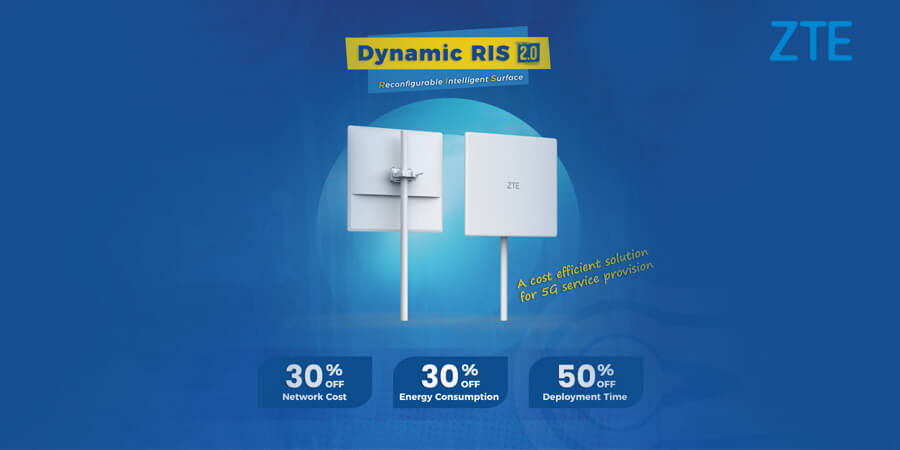Reconfigurable Intelligent Surface (RIS) is an innovative multi-antenna technology that utilizes electromagnetic meta-materials, which is considered to be one of the key technologies of 5G-A. RIS enables the extension of base station coverage by intelligently reflecting base station signals, resulting in improved coverage at a low cost and with low carbon emissions.
ZTE leads in this field and launched the second generation dynamic RIS product, ‘RIS 2.0’, during the MWC Shanghai in June 2023. Compared to its predecessor, the RIS 2.0 product offers significant advancements in terms of cost, power consumption, and reliability. Thus, laying a technical foundation for large-scale commercial use in the future.
Unique Technological Advancement
ZTE's dynamic RIS integrates over 17,000 surface elements in a panel for automatic codebook optimization and coordination with 5G base stations. This enables precise beamforming, with ultra-narrow beams, to achieve real-time tracking of devices across mmWave and mid-band spectrum.
By exploring a variety of materials, ZTE has launched RIS products for different scenarios, including enhancing outdoor coverage, improving outdoor to indoor propagation, achieving better coverage, a superior user experience, and supporting mobility.
Low TCO to Enhance 5G Coverage
Thanks to meta-materials, the architecture of dynamic RIS is simple and does not require expensive RF components, leading to low costs for RIS equipment.
Dynamic RIS maximizes the utilization of existing 5G sites without requiring new ones. It can be deployed on walls, billboards, and windows, which is much easier and less expensive to install compared to traditional 5G small cells. This reduces deployment costs and enhances spectrum efficiency, while providing improved coverage and capacity in limited line-of-sight (LoS) areas.
Based on verification, the hybrid network of mmWave base stations and dynamic RIS reduces costs by 30% and power consumption by 30%.
Green, Easy Deployment and Management
ZTE dynamic RIS panels use passive transmission that requires power only for beam steering, not for transmission. The power consumption is less than 20 watts, only a small fraction of that of a typical pico cell radio.
Dynamic RIS is easy and fast to deploy with a wide product portfolio to suit diverse scenarios, with visually unintrusive and small form factor. It can be managed by the wireless management system based on its coordination with 5G base stations.
Application Cases in Multiple Networks
In Thailand, ZTE completed the industry’s 1st dynamic RIS trial in commercial mmWave networks, achieving a 1.6Gbps downlink peak rate when users move within an office spanning over 400 meters.
Dynamic RIS has been applied in Hangzhou, China, in the Asian Games Village and stadiums, facilitating 8K high-definition streaming, virtual reality viewing, and interactive experiences both inside and outside the stadiums.
In addition, RIS was also deployed on jogging paths along the Qiantang River of Hangzhou and on cruise ships to provide a good 5G network experience for people on the jogging paths and spectators on the cruise ships.
